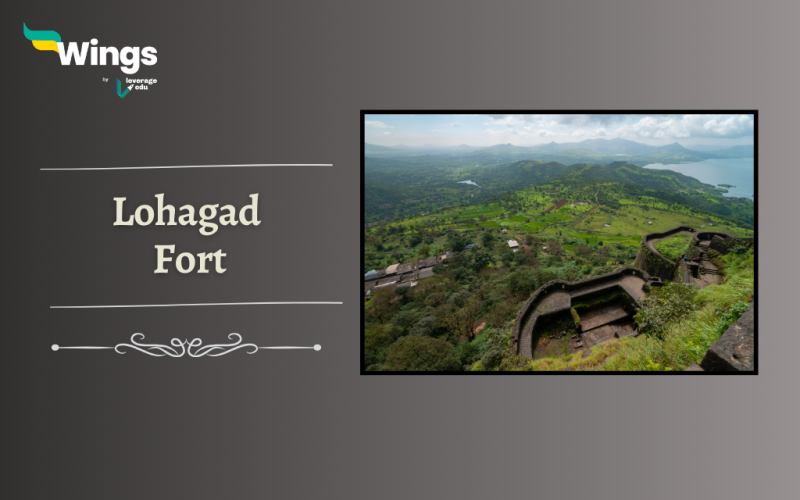Lohagarh Fort is also known as Iron Fort and is situated at the majestic hill of Lonavala, Maharashtra. It stands at an impressive elevation of 3,389 feet above sea level and offers breathtaking views of the lush green nature of the Western Ghats of India. The fort has a rich history that dates back to the 18th century from the Maratha Empire. Let’s delve into this blog and learn more information on Lohagad Fort history, features, facts and more.
Table of Contents
| Reconstruction by | Maratha Rulers |
| Location | Lonavala, Maharashtra |
| Timings | 9:00 am to 6:00 pm; Open Everyday |
| Entry Fee for fort | Free Entry |
| Camera | Allowed and Free |
History of Lohagad Fort
The name Lohagad is derived from two Hindi words – “Loha means Iron and Gad means Fort”.
- The fort witnessed the passing of the dynasties from Lohatmia, Chalukyas, Rashtrakutas, Yadavas, Bahmanis, Nizams, Mughals, and Marathas to the British administration.
- For a century, the fort was under the hands of the Nizam Shahi Sultanate, In 1636, the reign of the fort went to Mughal Emperor Aurangzeb.
- The fort came to its heyday when Chhatrapati Shivaji Maharaj took it into control in the year 1648 AD.
- Lohagad Fort played a strategic role in the defense of the region. It was used as a prison for political prisoners and as a lookout point to monitor enemy movements.
- With the treaty of Purandar, the Marathas had to give away 23 forts including Lohagad Fort in 1665 AD.
- The fort was later re-captured by the Mughals. Again, in 1720 AD, the Peshwa took the reigns and Nana Fadnavis took charge in 1770 and renovated the fort.
- By 1789, Nana Fadnavis fortified the fort, but by 1803, the Britishers brought heavy artilleries to capture the fort.
- Ultimately, on 4th March 1818, General Prother seized the fort and later the Britishers used the fort for their resources.
Features of Lohagad Fort
- Architecture: The architecture of Lohagad Fort is a fine example of ancient engineering skills. The fort is constructed using large stones and includes several gates, temples, and reservoirs.
- Entrance Gates: There are four gates to the fort named Maha Darwaza, Hanuman Darwaza, Ganesh Darwaza, and Narayan Darwaz. These gate features intricate carvings and offer a glimpse into the artistic prowess of the time.
- Visapur Fort: Lohagad Fort is located close to Visapur Fort, another prominent historical site. It is the sister fort of Lohagad Fort and at a higher altitude from the fort.
- Stepwells: The fort houses several structures including a temple, water reservoirs, and cannon towers with step-wells for water supply for the residents.
- Vinchukata: The northwest hill of the fort is shaped like a Scorpion’s tail and thus is named a Vinchukata.
Also Read –Neemrana Fort History: Features, Facts, Timings & More
Fascinating Facts about Lohagad Fort
- The fort is adorned with ancient inscriptions and carvings that offer insights into the cultural and religious beliefs of the time.
- Lohagad Fort is a popular destination for trekkers providing a perfect blend of adventure and historical exploration.
- The fort is declared a UNESCO World Heritage Site.
Also Read – Aguada Fort History: Features, Facts, Timings & More
Timings of Lohagad Fort
There are avenues of trekking at the fort and the timings for visiting the Monument and watching the mesmerising views are –
| Purpose | Timings |
| Entry | 9:00 am to 6:00 pm |
| Week Entry | Everyday |
| Entry Fee | No Entry Fee |
| Camera | Free |
In conclusion, Lohagad Fort stands tall to the rich history and architectural grandeur of ancient India. Its strategic location is a treat to the trekkers today and is a fort that reflects the strong powers of the Marathas and their treasures preserved at the fort.
Other Attractions near Lohagad Fort
| Bhaja Caves | Karla Caves |
| Lohagad Jain Caves | Khandala |
| Visapur Fort | Purandar Fort |
| Pawna Lake | Kondeshwar Temple |
Relevant Blogs
That’s all about Lohagad Fort history! If you want to know more about topics like this, then visit our general knowledge page! Alternatively, you can also read our blog on general knowledge for competitive exams!
 One app for all your study abroad needs
One app for all your study abroad needs













